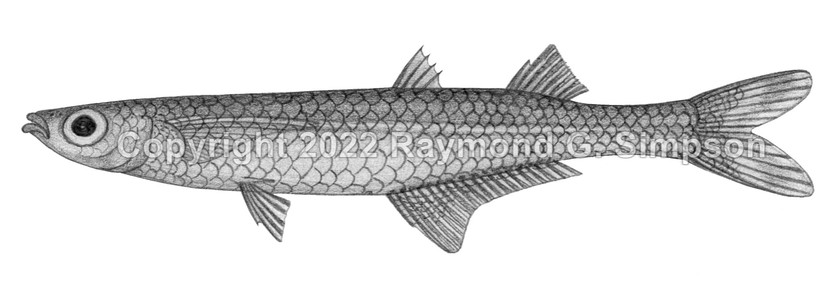
Common Name
Chagres Silverside
Year Described
Meek & Hildebrand, 1914
Identification
Dorsal Fin: II-V (usually IV); I, 7-9
Anal Fin: I, 18-24
Pectoral Fin: 12-14
Lateral Line Scales: 39-45
Predorsal Scales: 20-27
Circumferential Scales: 20-25 (modally 22)
Transverse Scale Rows: 7, rarely 8
Gill Rakers: 19-26
Vertebrae: 39-43
Body elongate, flat dorsally, and compressed laterally, with two dorsal fins. Eye large. Mouth terminal, strongly oblique, and does not reach the orbit. Premaxilla protractile. Distal end of premaxilla expanded. Premaxilla lacks postmaxillary process. Teeth in both jaws. Mesopterygoid teeth present. Rostral sensory system present. Anterior portion of sensory system consists of a pair of L-shaped furrows that are not fused together. Dorsal fins well separated. Spinous dorsal fin origin behind anal fin origin (above anal ray 3-7) and soft dorsal origin above anal fin ray 12-16. Anal fin long. Sheath present on first third of anal fin base. Pelvic fin origin well behind pectoral fin base. Axillary scale present (half pelvic length). Pectoral fin relatively long and high on body. Caudal fin forked. Scales cycloid.
Color
Body translucent with a golden yellow dorsum. Lateral stripe fairly thin (about a scale width or less than half eye diameter) and silvery. Faint dark cross-hatching on the dorsum. Patches of dense melanophores on head, snout, dorsal fin base, anal fin base, and base of caudal procurrent rays. Dorsal and caudal fin golden. Often bluish or aqua sheen on internal organs.
Size
Maximum size to 93mm SL.
Habitat
Primarily a freshwater species but occasionally found in brackish water at river mouths.
Range
Caribbean drainages of Costa Rica and Panama.
References
Chernoff, B. 1986. Systematics of American atherinid fishes of the genus Atherinella. I. The subgenus Atherinella. Proceedings of the Academy of Natural Sciences of Philadelphia, 86-188.
Other Notes
There is some variation in the meristics and morphometrics of this species between different drainages of Costa Rica and Panama so additional research is needed to determine if there are any cryptic species included in what is currently described as A. chagresi (Chernoff, 1986).